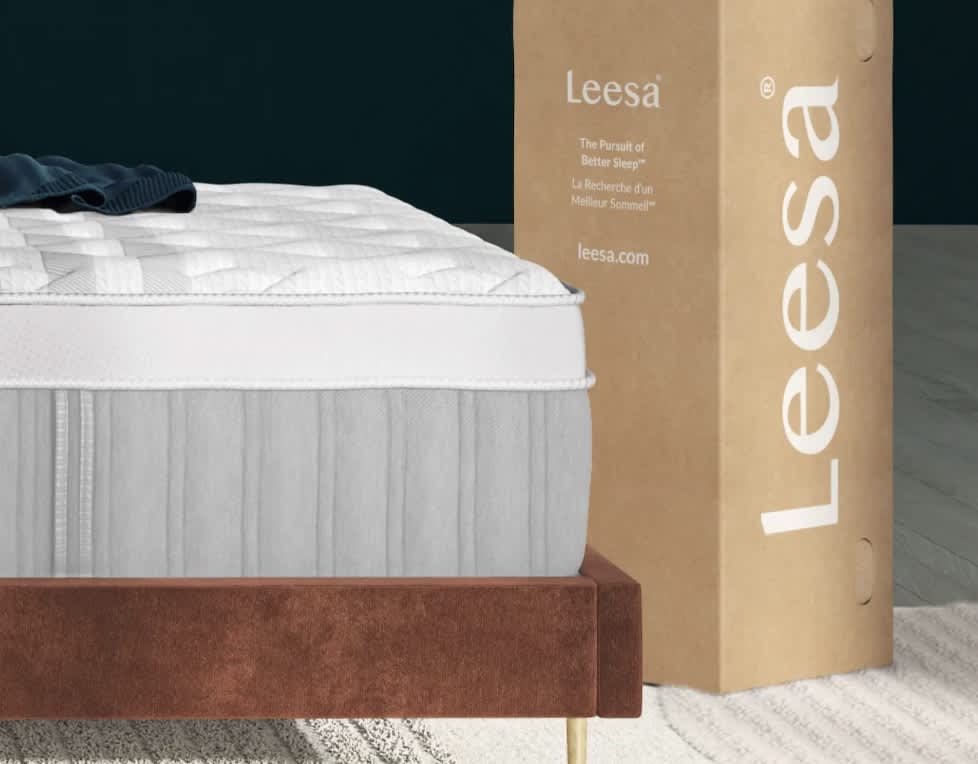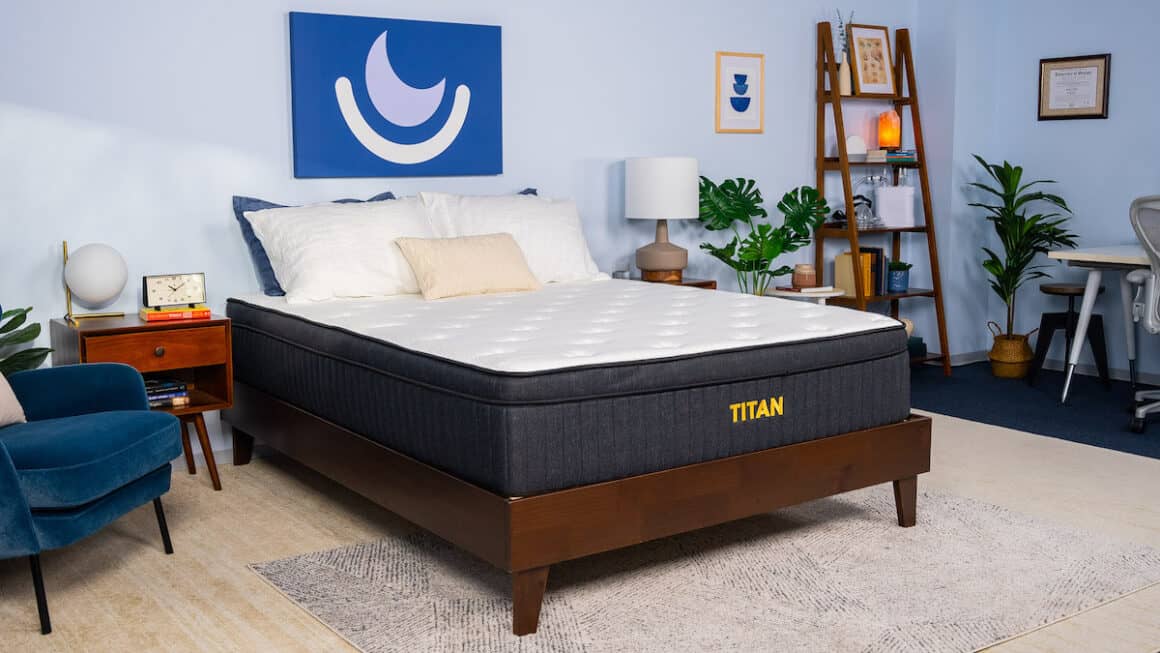On This Page
The Best Mattress for Combination Sleepers
Our Top Picks
-
Best Overall Mattress
Leesa Sapira Chill Hybrid -
Best Value Mattress
Brooklyn Bedding Signature Hybrid -
Best Luxury Mattress
Saatva Classic -
Best Mattress for Couples
Helix Midnight -
Best Mattress for Back Pain
WinkBed -
Best Mattress for Heavy Sleepers
Titan Plus Luxe
Best Overall Mattress

Conforming memory foam and responsive polyfoam work in concert with responsive pocketed coils to give the Leesa Sapira Chill Hybrid an effective combination of comfort and support. This mix makes it a flexible option that can help you maintain good spinal alignment no matter which position you use for sleep.
Pros & Cons
Pros
- Thick foam layers ease pain and pressure points in sensitive areas
- Three firmness options available
- Zoned coils provide extra reinforcement for the shoulders, lower back, and hips
Cons
- Off-gassing odor can be strong and unpleasant for the first few nights
- High-profile design requires a fitted sheet with deep pockets
Ratings
Our Take
Best Value Mattress

The Brooklyn Bedding Signature Hybrid’s high-quality materials and multiple firmness options make it a good choice for a wide range of sleepers, including combination sleepers. With its mid-range price-point and multiple cooling technologies, the Signature Hybrid also provides exceptional value for the price.
Pros & Cons
Pros
- Plush pillow-top and foam comfort layers help relieve pressure
- Pocketed steel coils provide responsive support
- Accessible price-point for a hybrid model
Cons
- Soft model may inhibit ease of movement
- Returns incur a fee
Ratings
Our Take
Best Luxury Mattress
Available in multiple firmness options and profiles, the Saatva Classic provides both flexibility and functionality for a wide variety of sleepers. The mattress’ dual-coil system offers ample pushback across all three firmness levels, and the plush Euro-top and zoned lumbar pad work together to provide solid pressure relief regardless of your sleep position.
Pros & Cons
Pros
- Coil-on-coil design makes the mattress responsive and easy to move across
- Quilted Euro-top and lumbar pad promote spinal alignment
- Available in three firmness levels and two heights
Cons
- Coils allow some motion transfer when sleeper switches positions
- Premium price-point
Ratings
Our Take
Best Mattress for Couples
The Helix Midnight is a great option for side sleepers, but enhanced support in the transition layer and core mean it can work well for back and side sleepers, too. It’s also quiet and easy to move on, making it a good choice for couples and active sleepers as well.
Pros & Cons
Pros
- Provides contouring pressure relief without overly limiting ease of movement
- Foam layers help isolate motion and prevent noise
- Coil support system and reinforced edges allow couples to use the entire surface
Cons
- Too soft for most stomach sleepers
- Extra charge for pillow-top cooling cover upgrade
Ratings
Our Take
Best Mattress for Back Pain
With high-quality materials and a construction that focuses on both comfort and support, the WinkBed is a solid choice for combination sleepers, particularly those with back pain. Its range of firmness options, additional support elements in the lumbar region, and pressure-relieving pillow-top make the WinkBed an adaptable choice for any sleep position.
Pros & Cons
Pros
- Zoned coils provide targeted support to promote spinal alignment
- Strong edge support allows use of the full bed
- Four firmness levels to choose from
Cons
- Soft model limits ease of movement
- Some all-foam mattresses offer more pressure relief
Ratings
Our Take
Best Mattress for Heavy Sleepers

The Titan Plus Luxe takes Titan’s hybrid design and adds a layer to the comfort system, as well as two additional inches of coils. The extra cushioning and bouncier profile give the Luxe a medium firm (6) feel that works for a wider range of sleepers while still offering superior support for heavier people.
Pros & Cons
Pros
- Designed to provide a plusher option for individuals weighing up to 500 pounds
- Quilted gel-foam top and adaptive foam comfort layer deliver subtle contouring
- Responsive surface designed for easy position changes
Cons
- Coil system produces some motion transfer when changing positions
- May emit a temporary off-gassing smell after unpacking
Ratings
Our Take
Compare Our Top Picks
| Mattress | Mattress Type | Ideal For | Value | Sleep Trial |
| Leesa Sapira Chill Hybrid | Hybrid | Couples | Good Value | 120 nights (30-night requirement) |
| Brooklyn Bedding Signature Hybrid | Hybrid | Couples | Great Value | 120 nights (30-night requirement) |
| Saatva Classic | Innerspring | Back Sleepers | Fair Value | 365 Nights ($99 Return Fee) |
| Helix Midnight | Hybrid | Combination Sleepers | Good Value | 120 nights (30-night requirement) |
| WinkBed | Innerspring | Side Sleepers | Good Value | 120 nights (30 night requirement) |
| Titan Plus Luxe | Hybrid | Sleepers Over 230 Pounds | Great Value | 120 nights (30-night requirement) |
Combination sleepers have a balancing act to do when it comes to their mattress. You’ll need to look for a bed with an in-between feel that works for all your sleeping positions. You’ll also need to find the right balance between motion isolation and ease of movement so you can change positions in the night.
What Is the Best Firmness for Combination Sleepers?
The best firmness level for combination sleepers is the one which provides ample support for all your sleep positions. Each sleeper experiences firmness differently, so whether you choose a firm or soft mattress depends on your body type, personal preference, and typical sleeping positions.
Since combination sleepers need a mattress that supports more than one position, they often opt for the balanced feel of a medium firm mattress. Alternatively, some mattresses offer dual firmness levels – one on each side – or adjustable firmness levels that adapt while you sleep.
Keep in mind that your body type also determines how you experience firmness. Generally, sleepers under 130 pounds need a softer mattress than those who weigh over 130 pounds.
- Less than 130 lbs.: Medium Soft (4) to Medium Firm (6)
- Between 130 and 230 lbs.: Medium (5) to Medium firm (6)
- More than 230 lbs.: Medium Firm (6) to Firm (8)
How to Choose a Mattress for Combination Sleepers
Combination sleepers need to consider many of the same factors as other sleepers when choosing a mattress. However, they should evaluate many of these aspects from a different perspective which takes into account their unique needs.
Mattress Type
Mattresses are classified according to the materials used in their construction. Each mattress type has different advantages and disadvantages.
Foam mattresses are constructed from memory foam or polyfoam and usually offer a surface that conforms to the body. Hybrid mattresses combine a coil support system with comfort layers to create a balance between cushion and responsive pushback. Latex mattresses provide a bouncy, moderately contouring surface.
A few less common types of mattresses directly address the needs of combination sleepers. Air beds consist of comfort layers placed over a large air chamber. The sleeper can adjust the firmness of the mattress by adding or subtracting air using a remote control or smartphone app. Alternatively, split mattresses are like two smaller mattresses pushed together, often with a different or adjustable firmness level on each side.
| Mattress Type | Pros | Cons |
| Foam Mattresses |
|
|
| Hybrid Mattresses |
|
|
| Latex Mattresses |
|
|
| Airbed Mattresses |
|
|
| Split Mattresses |
|
|
Ease of Movement
Since combination sleepers move, toss, and turn in order to change positions, it’s important that the mattress doesn’t inhibit movement. Generally a responsive surface with some pushback and bounce is most conducive to movement. Coils and latex promote easier movement, while softer foam mattresses may conform closely and cause you to sink or feel stuck.
Edge Support
Edge support refers to how much the perimeter of a bed sinks under pressure or weight. Mattresses with strong edge support allow you to use the entire surface. Combination sleepers may need this extra space to comfortably switch positions, especially if they share a bed with someone else. Many mattresses have reinforced perimeters to combat sagging at the edges.
Motion Isolation
Motion isolation refers to how much of a sleeper’s movement travels across a bed. Beds that absorb motion well prevent your tossing and turning from disturbing your partner. Combination sleepers tend to move often throughout the night, so those who share the bed with a light sleeper should prioritize mattresses with strong motion isolation.
Foam isolates motion better than other materials. However, because of its conforming properties, there’s often a trade off between motion isolation and ease of movement. Keep your personal preferences and priorities in mind when deciding what balance is right for you.
Body Pain
Mattresses can help alleviate body pain by providing pressure relief and promoting healthy spine alignment. Likewise, a mattress which offers insufficient support or cushion can worsen aches and pains.
Combination sleepers with body pain should consider a mattress that offers moderate conforming or cushioning to relieve tension, but also targeted support to reinforce proper sleep posture. To select a firmness level that offers ample support, take into account your body type as well as all of your sleep positions.
Sleep Trial and Warranty
Sleep trials offer a chance to try out the mattress for a specified amount of time and return it for a full refund if it doesn’t meet your needs. Offers like these are especially useful for combination sleepers, who may need to try more than one firmness level or mattress type before finding one that accommodates them.
Warranties protect against manufacturing defects for a certain amount of time, with an agreement to replace or repair your mattress should any arise.
Each company has different terms for sleep trials and warranties, and it’s important to read the policy carefully before making a purchase.
Video: How to Shop for a Mattress
Watch our video to learn more about what to look for in a mattress, including the different types as well as important features like firmness and support.
Comfortable Sleeping Tips for Combination Sleepers
Beyond choosing the right mattress, there are several simple ways you can level up your sleeping experience if you’re a combination sleeper.
- Buy the right pillow: As a combination sleeper, you need a pillow that supports your head and neck and promotes healthy posture for multiple sleeping positions. The best pillow for you depends on a combination of the pillow’s firmness and height, or loft. Medium firm pillows with a mid-level loft usually perform best for combination sleepers. Adjustable pillows that allow you to subtract or add fill can also be a good option.
- Use pillows for extra support: A well-placed extra pillow can help pick up the slack in any area that’s lacking support. For example, a pillow under your midsection or hips can help with spinal alignment while stomach or back sleeping. Placing a pillow between your knees can help keep the pelvis and spine neutral when lying on your side. Body pillows can also help align your head, neck and spine.
- Try a mattress topper: Mattress toppers are placed on top of the mattress and can help adjust the firmness level. Combination sleepers may want to consider a split firmness mattress pad, which offers a different firmness level on each side to accommodate different positions. Practice healthy sleep posture: For healthy sleep posture, keep your ears, shoulders and hips aligned throughout sleeping positions. Keeping proper posture helps prevent aches and pains and promotes spinal alignment.
Discover More Mattress Solutions
No matter what your sleep position, preference or body type, our expert testing team can help you find the perfect mattress. Check out our different mattress guides below.
More Mattress Guides
How We Test
To find the best mattresses for combination sleepers, we subjected dozens of mattresses to our rigorous testing methodology. We gathered data using in-person testing as well as modern technology and analyzed it according to the latest research about combination sleeping and sleep posture.
Our diverse testing team spans every sleeping position and body type to ensure that we account for the unique needs of all types of combination sleepers.
Frequently Asked Questions
Combination sleeping is not inherently unhealthy or healthy. Its effect on your body and your rest depend on finding a mattress that offers adequate support for the different positions you adopt during the night.
While choosing a proper mattress is slightly more complicated since you have to account for more than one sleeping position, there are many quality beds available for combination sleepers.
Memory foam can be good for combination sleepers because it helps relieve pressure and isolates motion. However, it’s important to choose the correct firmness level for your body type, as a soft memory foam mattress may conform too closely or sink, making it harder to switch positions. If the mattress is too soft, it may also lead to poor spinal alignment.
The best mattress firmness for a combination sleeper depends on their body type, and which positions they shift to during the night. Often, a medium firm mattress that balances cushion and support works well. However, each sleeper experiences mattress firmness subjectively. For example, while heavier people generally prefer a firm mattress, a sleeper who weighs over 230 pounds may find a medium firm mattress still too soft.
Split mattresses and flippable mattresses often offer two different firmness levels, which sleepers must choose between. There are also adjustable air beds available that allow sleepers to control the firmness to a precise degree using a remote or an app. Some models automatically adjust throughout the night based on the sleeper’s position.
The best pillow loft, or height, depends partly on which positions the combination sleeper shifts to. Side sleepers require a thicker pillow to support the neck, while stomach sleepers need a thin pillow or no pillow at all in order to minimize curvature of the upper back. In general, a mid-level loft works best to accommodate the different positions of a combination sleeper.
